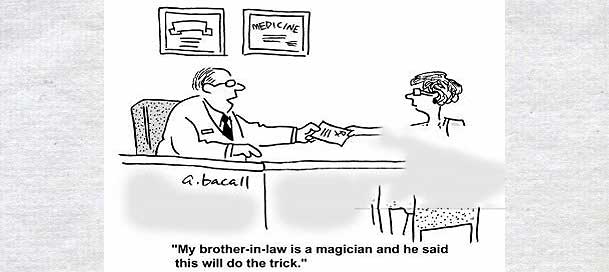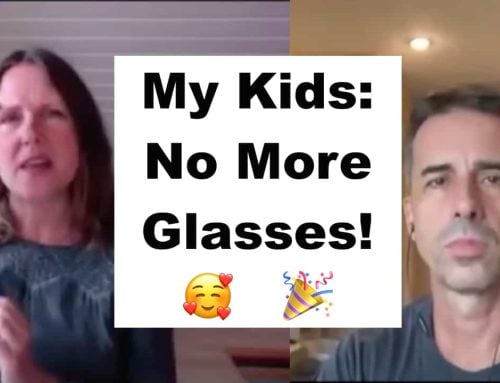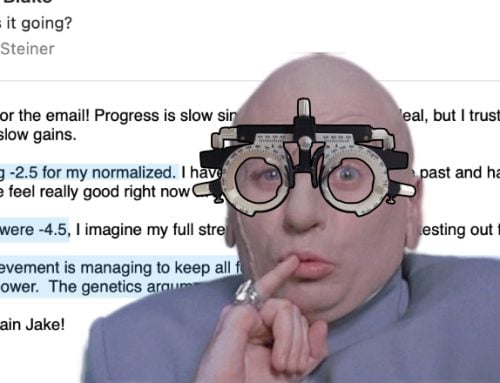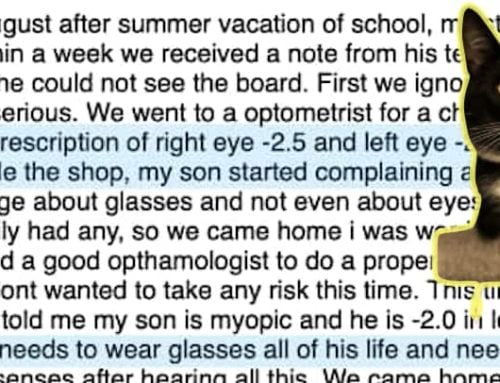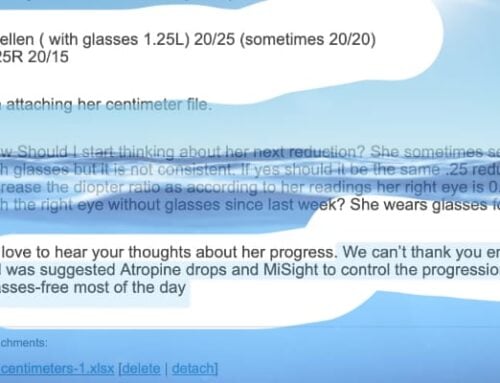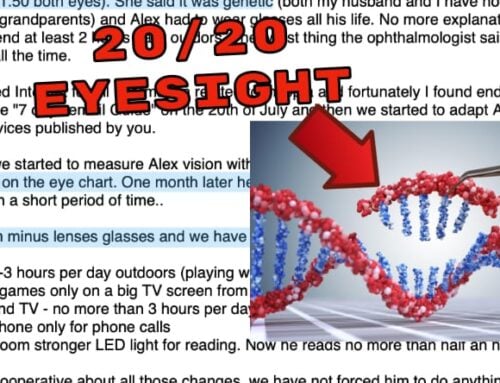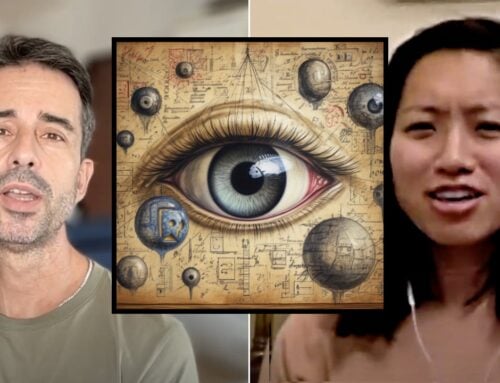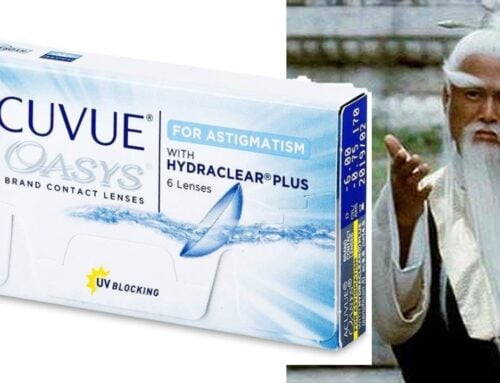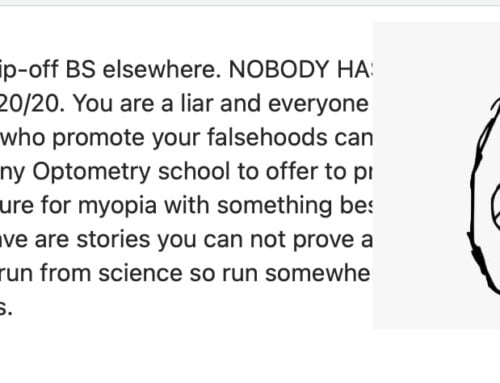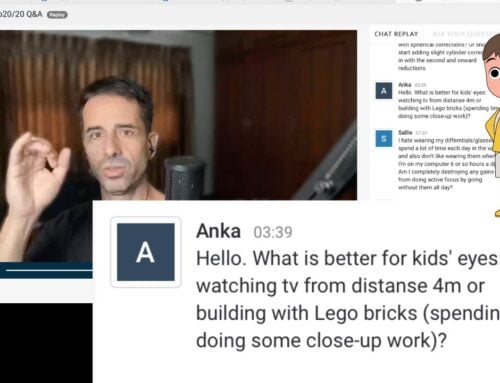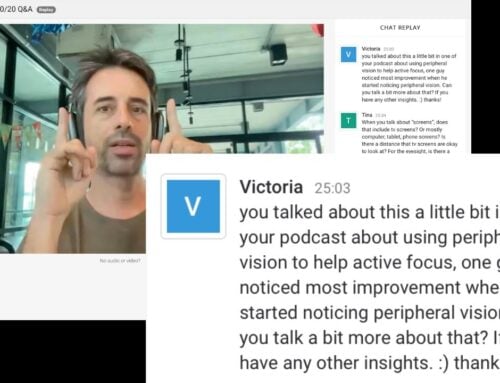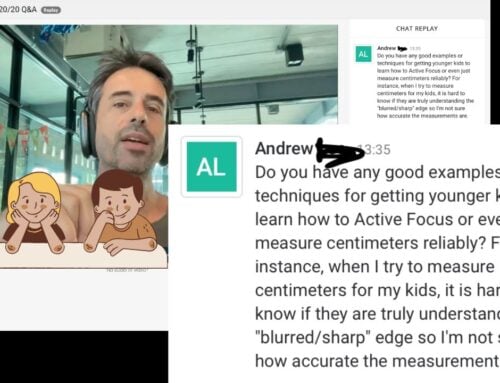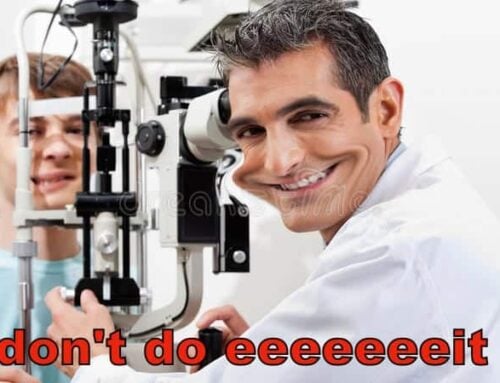Book progress update.
For long time readers, no brand new insights here.
The task at hand is to take all the key insights and get them into a readable book format. Parents who care about their child’s eyesight, busy a they are, will want things succinctly and clearly explained.
It’d be an easier task if I was a writer. ;-)
But here we are. More excerpts from the upcoming child myopia book:
The Diagnosis
The first thing you have to understand is how the optometrist visit relates to your child’s eyesight. This is not, as you might expect, a neutral, unbiased, “doctor checkup”. It’s the perspective that affects how you experience the visit to the optometrist with your child. Let’s add some reality to that perspective:
Look at the optometrist visit as a sales pitch. You are expect to leave there having spent money, and bought something.
Depending on where you live and where you go for a checkup, the actual consult may in fact be free of charge. This should be a really big red flag. Why do they give away the doctor’s visit? Don’t they have to pay rent, employees, utility bills, advertising, etc etc?
Of course they do. For the first clue, look around the optometrist office the next time you see one. How big is the space where eyesight is evaluated? Now compare it to the rest of the office. What do you see? In case you haven’t been to one yet, or not in a while, let me provide some clues. You see fancy overhead lighting, lots of mirrors, nice inset counters with glass tops, and lots and lots of fashion brand logos. You see price ranges, special promotions, and you have smiling sales staff offering to help.
What is this? Is this anything like a hospital, or the experience you have when you get a regular medical checkup?
Of course not. This is a retail sales space. It is set up to sell you something. If you go in there and get an eye checkup, they will find something “wrong” with your eyes. If a hundred people walk into the office for a checkup, at least 90 of them are walking out with a prescription, and new glasses. The optometrist pays off his student loans, pays for his staff, his livelihood, not from examining eyes. He makes a living from selling you fashion frames, and lenses.
You have to keep this in mind for all of the rest of this book. Yes certainly your child’s eyes may show some myopia. But it may not be the kind of myopia that your optometrist will have you believe. Early myopia is almost never (never, ever) a sign of an eye illness, or a hereditary problem, or generally anything that couldn’t be fixed rather than permanently medicated through prescriptions. It’s the sales process, the pressure on the optometrist to convert you as the “prospect” into a “buyer” (optometry related brochures may actually refer to you and your child by those exact terms). You aren’t getting a sympathetic or unbiased diagnosis.
We’ll start here with the basics. In a bit we’ll look at what myopia actually is, how it evolves, how you can stop the whole problem in its tracks. But for now and to understand where that first frightful diagnosis come from, we have to start with the voice of the optometrist. And now your eyes are already irrevocably opened to the nature of the business, and you will look at that optometrist office under a different light. Look at the sales tactics, and stop thinking of that place as some sort of benign “medical” establishment.
Now that we understand the basic economic incentive, let’s look at the actual diagnosis, and how it is created. Let’s look at how the odds are stacked several against your child’s eyes, and towards the shop’s bottom line. The eye exam is almost “unwinable”, since it is designed that way.
First, we have the element of fear and authority, created for your child. The room with the unnecessarily imposing chair (seriously, that chair has magician’s prop written all over it). The large lens exchanger that hangs from a gleaming metal arm, hovering over your child. The optometrist, almost in an insult to medicine, probably in some sort of white labcoat, which is entirely a farce (what do we need a lab coat for? blood splatters?). Then we have equipment that will further make your child nervous and elicit compliance. You never see as well when you are nervous. Making a child read tiny letters, while anxious, that is a formula for a less than perfect performance. The autorefractor is usually the first step. Look inside, and a few moments later the machine prints out an ominous piece of paper. Or perhaps it isn’t ominous but it’s almost certain that your optometrist will look at it, brows a-furrow, making absolutely zero further explanations (a staple trick of the profession, to tell you nothing). Then the gleaming arms swings around, the lights are dimmed (here too, more misdirection), and now it’s time for the eye chart.
Let me interrupt myself here, for a brief moment. In a following chapter I will show you how to do the exact same measurements at home. They are completely indistinguishable in function and accuracy from the optometrist office. You can do them for almost free, or at most spend half of what those new glasses would cost, to get all the equipment that the optometrist in actuality relies on. You’ll enjoy that chapter, as it unmasks all the hocus-pocus charades of the optometrist visit.
Back to our little magic show. Now we have the darkened room, and the eye chart on the wall, lit with some artificial light source. It appears brightly lit though if you were to measure the light it would actually be fairly dim. This as you probably don’t know yet is what we call worst case scenario of vision. Your child’s pupils dilated, no peripheral vision, looking through the tunnel of the lens exchanger, nervously, onto a dimly lit chart. If you want to know when your eyes can see the least well, this is it. Other than just making the room dark and yelling “BOOH!”, this is about as stacked as the odds will ever get against your child’s eyes.
What’s the outcome of this Spanish inquisition of the eyes? Surprise, surprise. Your child needs glasses. Have we mentioned our fine selection of child friendly spectacles? We have great child fashion styles, we have some unbreakable titanium frames, we have some new ultra thin, unbreakable lenses, with special coatings and even more special coatings, and we have a new two for one promotion, and we have ………….
Stop me if any of this strikes you as just even a little bit fishy.
This is what happens. Period. If you have a different experience, it’ll be a rarity. Go to any local mall, pop into any optometrist office, and tell me you have a different experience. For laughs if you happen to have good vision and don’t need glasses, just go to one of those optometrists. See if they don’t manage to try to sell you something anyway.
None of this negates that there is a problem with your child’s eyes. Because indeed there is a problem, I don’t want to mislead you into thinking that everything is fine. But it’s not a problem that can only be fixed by starting a permanent descent into a life behind glasses. It’s a problem that can be approached looking at causes, at prevention, at symptom reversal. Your child is fundamentally healthy. If you are worried about doing a proper checkup, go to an ophthalmologist (not optometrist), one that isn’t set up as a retail sales space. Be charged for a proper checkup without any sales pitch. That’s a checkup. And even that might reveal a problem and again, just because somebody is equipped to tell you about a symptom, doesn’t in any way suggest that they are the best resource to suggest a solution.
The only great way of dealing this child eyesight in terms of myopia is taking matters into your own hands. You will want to do your own measurements, since there is a lot more to your child’s eyes than five minutes in a darkened sales office will reveal. You want to do multiple measurements at different times in the day, and you want to know what it all means. You don’t need somebody in a lab coat checking out some print out, not telling you a thing until it’s time to pitch you some fancy fashion glasses. There is sales, and there is knowledge. In this case they tend to be mutually exclusive. All this isn’t to say that you should avoid all eye exams. As I’d said earlier, you want to have that annual checkup with a good ophthalmologist, and keep an eye out for being sold things. Pay up front for the service, a cost that seems far larger than the free or very cheap optometrist office. You’ll know you aren’t being roped into an unforeseen sale. Pay up front, get unbiased answers. And still, take the myopia part of the diagnosis and read this book before forming an opinion about suggested treatment avenues. We’ll thoroughly explore what science says about myopia, and what parents say of their children who managed to completely recover from the condition altogether.
—
Hopefully we are on the right track here.
I’m dedicating an hour a day to writing, to finish this up. So far we have eight chapters, two more to go.
Then it’ll be on to sorting out sales channels and promotion, and hopefully a good new tool for parents to find out how to keep their child’s eyes in good health.
Cheers!
– Jake

